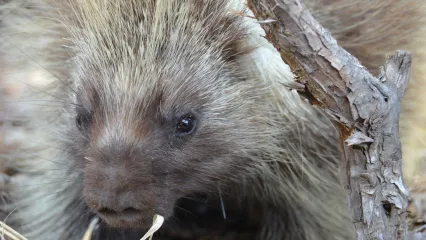
Description
The northern long-eared bat is a medium-sized bat about 3-3.7 inches long, with a wingspan of 9-10 inches and an average weight of a quarter of an ounce. Its fur can vary in color between medium and dark brown. The northern long-eared bat can be distinguished from other members in the genus Myotis by the ear length, which extends past the tip of the nose when laid forward.
Size
Approximately 3-3.7 inches long, with a wingspan of 9-10 inches
Habitat
The northern long-eared bat occurs throughout portions of both the Ozark highlands and Ouachita Mountains regions in eastern Oklahoma. At least nine northern long-eared bat hibernacula are known in Oklahoma, though multiple individuals have been documented at additional cave locations. The northern long-eared bat has been found using limestone caves in the Ozark highlands that are used by other federally-listed bats, such as the gray bat and Ozark big-eared bat. Unlike those species, the northern long-eared bat does not rely on caves for its entire life cycle. Specific summer roosting habitat in Oklahoma is generally unknown, but this bat likely uses a variety of different tree species. They are suspected of switching roost trees every few days.
Life Cycle
Throughout its life cycle, the northern long-eared bat uses both caves and trees as roosting sites. Unlike other bats, this species does not gather in large colonies in winter and single bats and small groups will often hibernate in narrow cracks or crevices in caves. Northern long-eared bats most commonly forage within forest interiors and are adapted for moving through dense wooded areas. They often feed on insects by “gleaning”, which involves capturing insects that are stationary on vegetation and water surfaces. These bats breed in the fall, when males and females gather near winter hibernacula and engage in a behavior called “swarming”. After mating, females delay reproductive development until spring, at which point they emerge from hibernacula and seek a maternity roost tree. Reproductive females gather in maternity colonies that range from less than five individuals to over fifty bats. Males and non-reproductive females will use both trees and caves as roosts during this time period.
White-nose syndrome, a disease that affects hibernating bats, has caused population declines in portions of the northern long-eared bat range. Historically, this species was considered to be a relatively widespread and common species, and it continues to remain abundant in many areas. Although the Oklahoma portion of its range has not experienced these declines, it remains unknown as to how the spread of the disease will ultimately affect the overall recovery of the species. In Oklahoma, five of the nine known primary northern long-eared bat hibernacula sites occur on the Ozark Plateau National Wildlife Refuge. In addition, cave gating and monitoring efforts on private lands in the Ozark highlands have benefited northern long-eared bats, especially through the long-term ESA Section 6 grant with Rogers State University. Another component of northern long-eared bat recovery is ensuring the permanent protection of important caves through property acquisition. Through Recovery Land Acquisition funding, the Wildlife Department has assisted the Oklahoma Chapter of The Nature Conservancy with important land purchases that have conservation benefit for the species.
How To Observe
Learn more about this and other Oklahoma bats in the free "Bats of Oklahoma Field Guide."


